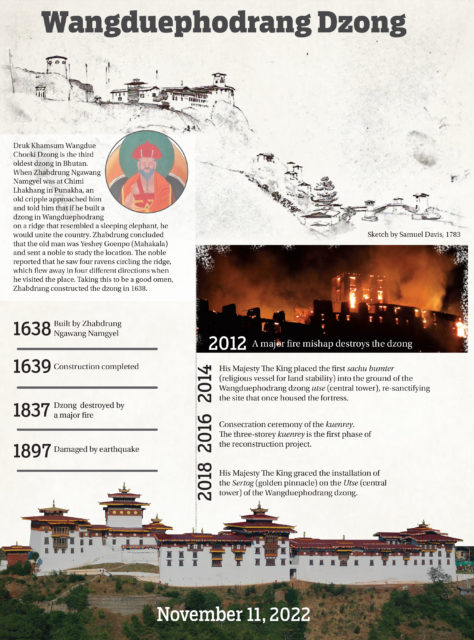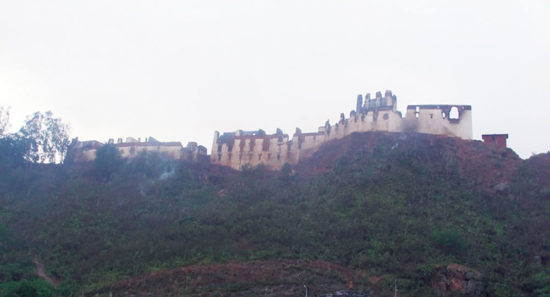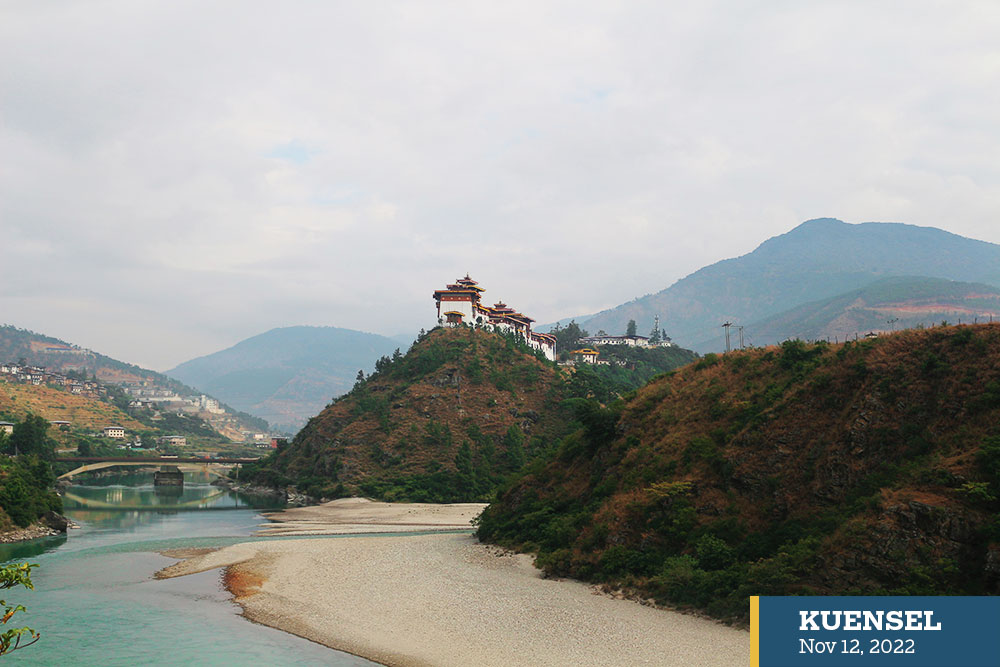Jigme Wangchuk
November 11, a serene morning at Gangtey Thangka, Wangdue. As the first rays of the autumn sun touch the aureate fields of the hill opposite, painting a pastoral portrait of medieval Shangri-La, the Druk Khamsum Wangdue Choeki Dzong, known popularly as Wangdue Dzong, shimmers atop the ridge that resembles a sleeping elephant. Far dawn, from the Tsangchhu Zam, this singular wonder of Bhutanese ingenuity stands resplendent, towering, and proud, floating in the sky.
Ten years ago today, a fire accident engulfed this most unique and magnificent of Bhutanese dzongs which was originally built in 1639 by Zhabdrung Ngawang Namgyel. A popular narrative has it that while in Chimi Lhakhang in Punakha, an old cripple approached Zhabdrung Rinpoche. The protecting deity Yeshey Goenpo or Mahakala of the glorious Palden Drukpa in disguise, the old cripple advised the peerless founder of Lhomon Tsendhen Jong or Drukyul to build a dzong overlooking the confluence of Dangchhu and Punatsangchhu if he were to bring the dominion of the Southern Land of Medicine under him.

The dzong is believed to have been enlarged by the Fourth Desi, Gyalsey Tenzin Rabgye, who also added two more storeys to the Uste. In 1837, the dzong was destroyed by a great fire and was rebuilt. During the time of Neten Pelden Singye, the dzong was damaged by a severe earthquake and rebuilt to its former glory. Once again, during the reign of the Third King Jigme Dorji Wangchuck the dzong saw a renovation under the supervision of Dronyer Pema Wangdi.
When the fire razed the dzong to the ground on the evening of June 24, 2012, a pained nation stood stunned in disbelief. The utter feeling of helplessness as the people watched the inferno devour the nearly 400-year-old dzong is so deeply etched in human memory that the people still recall with the event tears. The then Wangdue Dzongdag Lhendup Wangchhu was among the few who managed to get inside the dzong, soon after Bhutan Power corporation informed him about the fire. The people inside the dzong were trying to create a fire-line to stop it from spreading towards the dratshang. It was a futile effort in the end. The main statue of the Zhabdrung was lowered down from the window with the help of big ropes that were available from the scaffoldings. Only precious little could be salvaged. Today, as the Je Khenpo consecrates the new dzong, it marks a new beginning for the nation, particularly for the people of Sha Dargye (eight divisions of Sha).

Fire razed the dzong to the ground in 2012
His Majesty The King, Her Majesty The Gyaltsuen, His Majesty the Fourth King, members of the Royal family, and senior government officials attended the consecration ceremony.
As the dzong was being consumed by fire, contributions began to flow immediately from individuals and organisations for the reconstruction of the dzong. In less than a month, the government mobilised Nu 1.3B to fund the dzong’s reconstruction. In solidarity, Bhutan’s neighbour and friend, India, committed Nu 1 billion for the reconstruction project. On January 2014, reconstruction of the dzong began. On July 14, His Majesty the King graced the installation of the sertog (golden pinnacle) on the utse of the dzong.
Phento, a villager, watched the event from Rinchengang. “I saw history burn to dust and now I see it rising again…I couldn’t sleep for days after that fateful day.”
The dzong reconstruction project was not easy; it progressed slowly. The recommendations of experts had to be presented to the steering committee of the project on January 24. Based on the recommendations, the culture department had to work on how to go with the utse construction, keeping in mind the original structural and cultural components. More than 320 workers, 53 open-air prisoners, and 30 carvers were engaged in the kuenray construction.
Fire accidents are common in dzongs and lhakhangs. And there is the threat of natural disasters such as earthquakes. The new Wangdue Dzong was rebuilt with these dangers in mind. The dzong is the first in the country to have used a base isolation system, a method of seismic protection where the structure or superstructure is separated from the base or foundation. Among other modern amenities, the dzong has fire alarm control panels and an underground service tunnel where internet, sewage and electricity lines run through.
Druk Khamsum Wangdue Choeki Dzong, thus, is a model dzong.
“No such fire disaster should destroy any dzong in the country,” said Kencho Tshering from Bajo Town.


